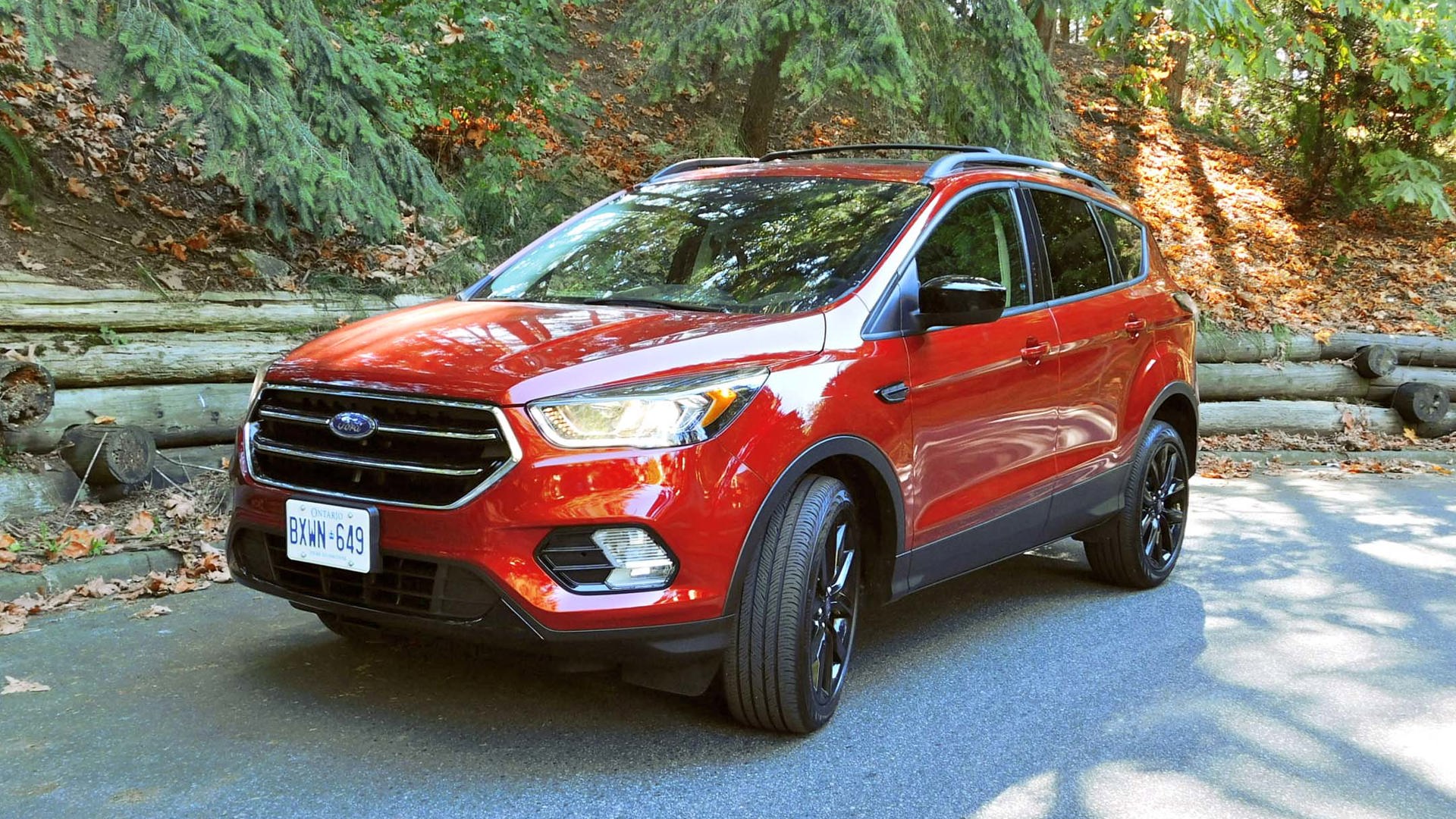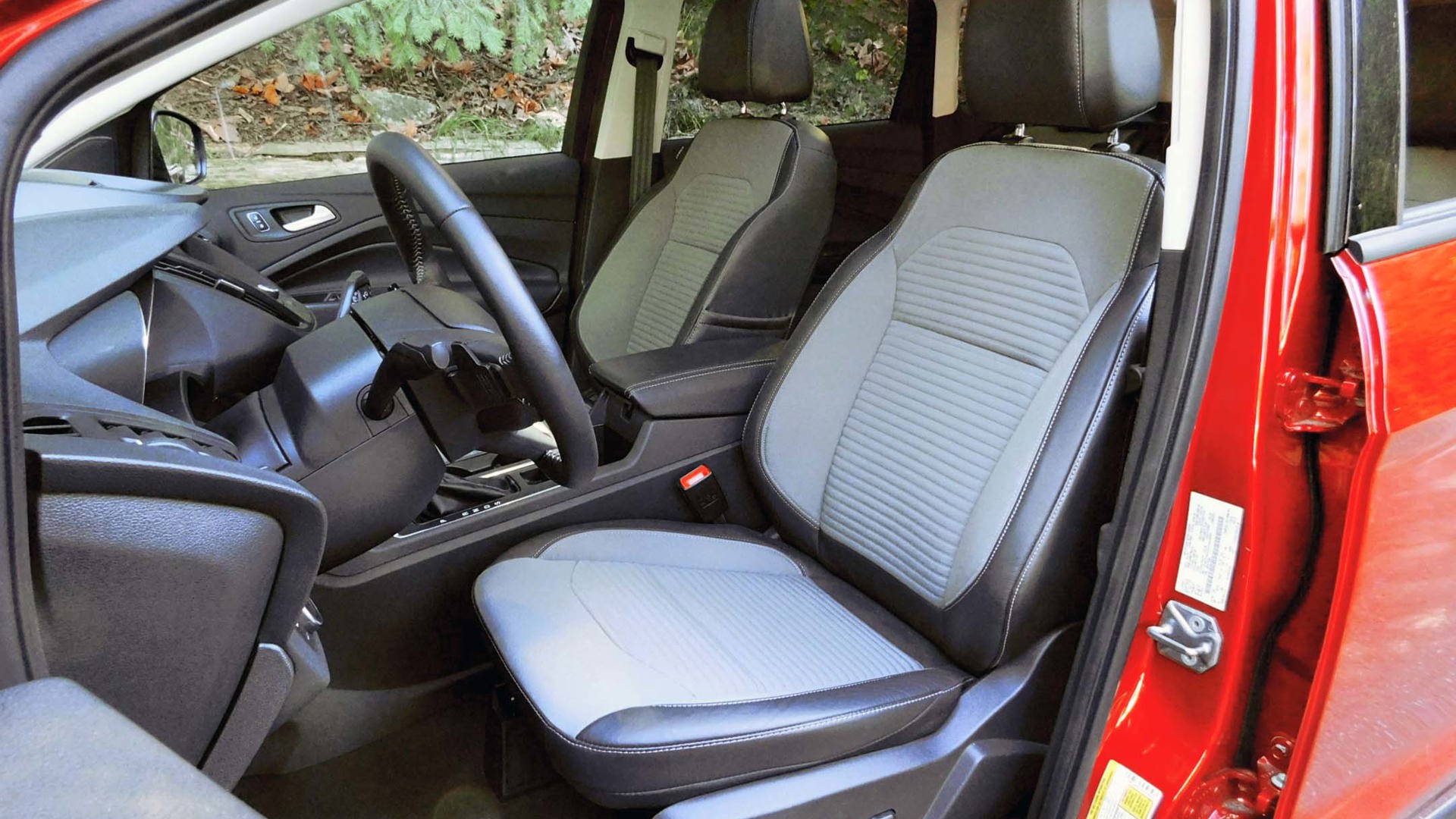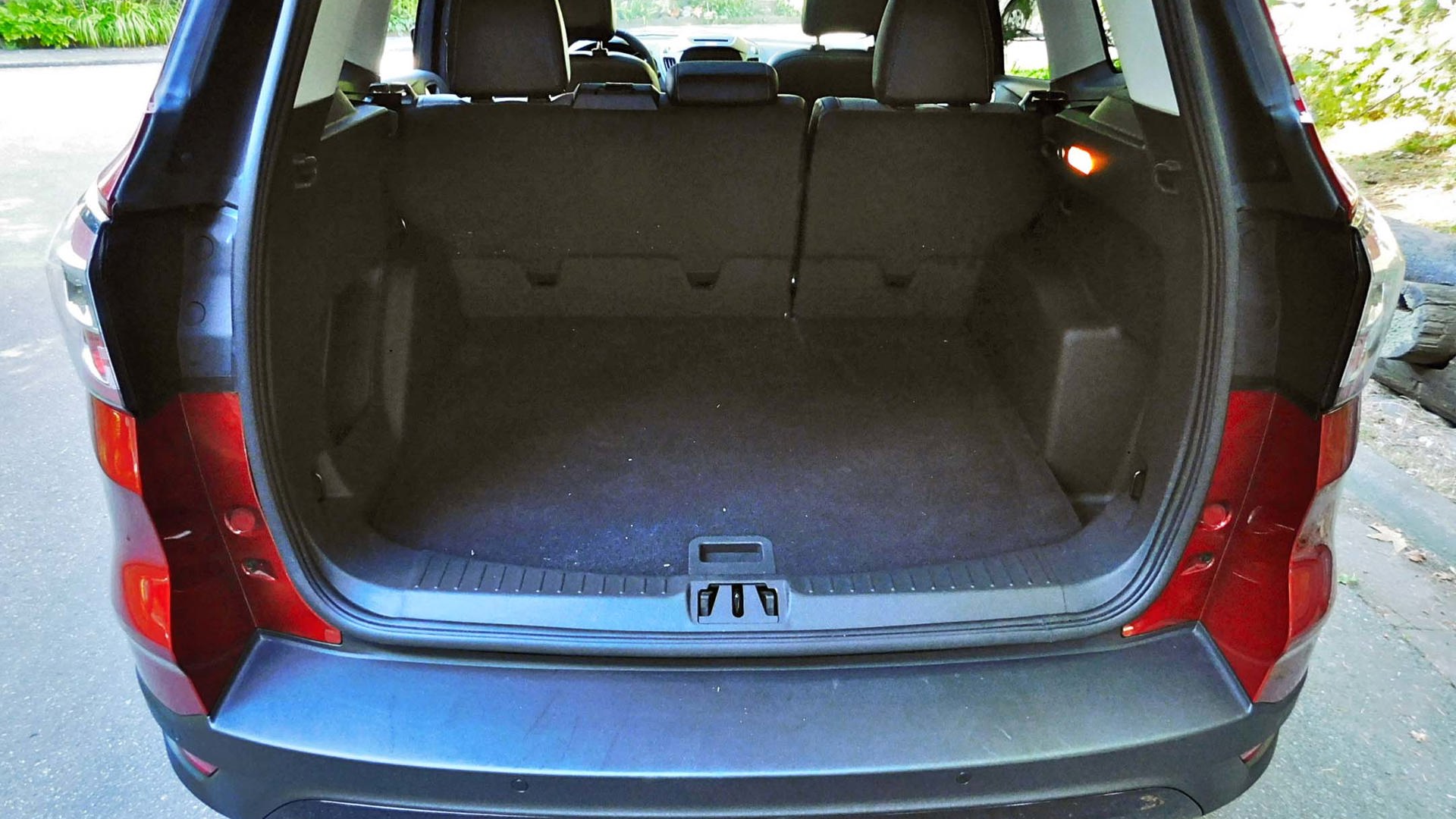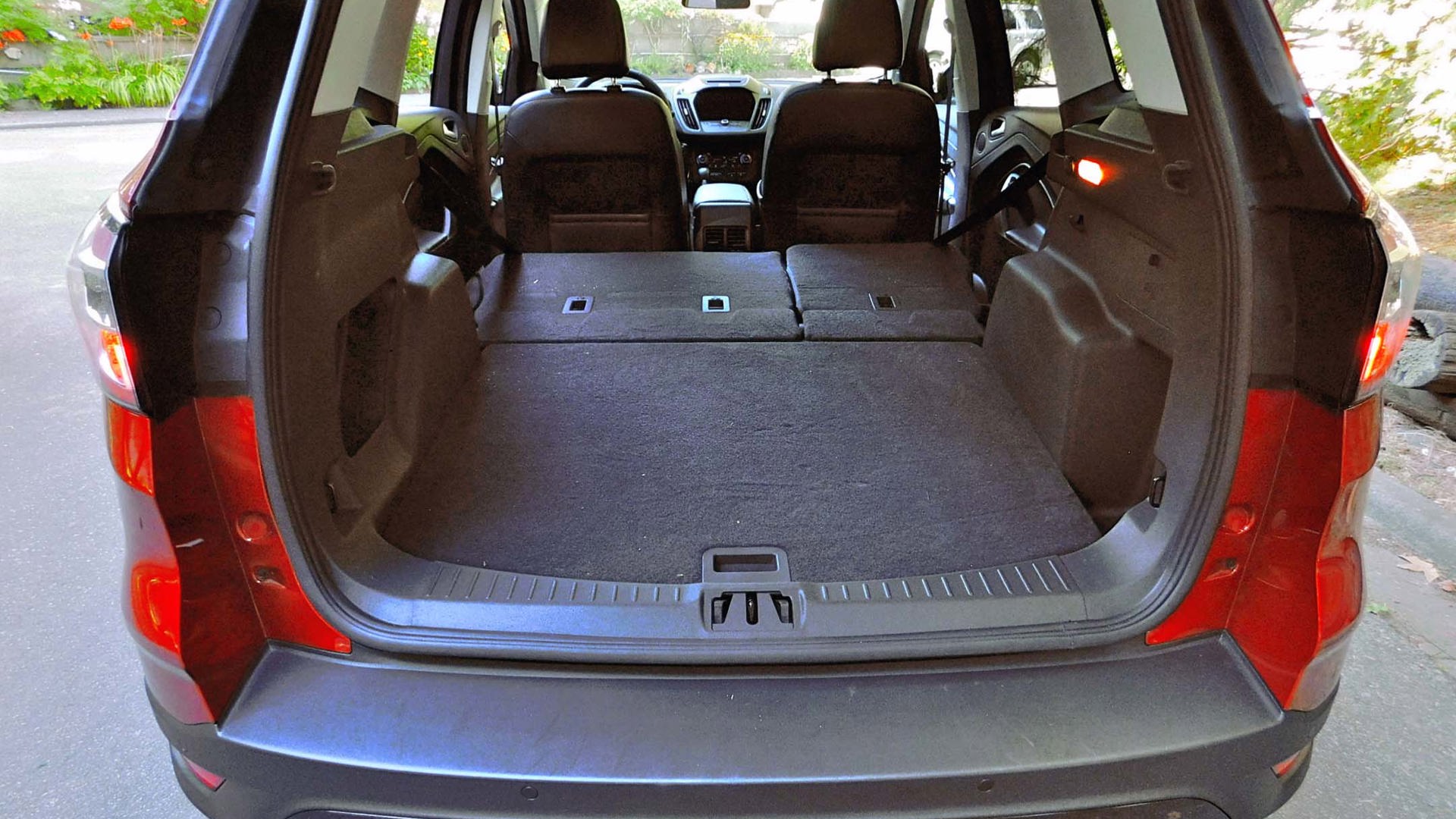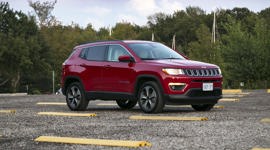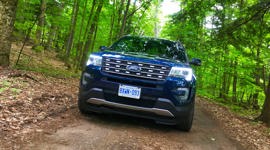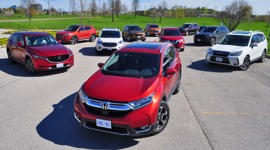 AutoTrader SCORE
AutoTrader SCORE
-
STYLING7/10
-
Safety6/10
-
PRACTICALITY8/10
-
USER-FRIENDLINESS7/10
-
FEATURES9/10
-
POWER7/10
-
COMFORT8/10
-
DRIVING FEEL7/10
-
FUEL ECONOMY6/10
-
VALUE8/10
Since its introduction for the 2001 model year the Escape has been a consistent winner for Ford. It’s currently the number-one seller in a hot segment – Canadians bought over 341,000 small crossovers in 2015 and are on track to beat that number in 2016 – and for 2017 Ford has made a number of changes to keep the current third-generation model at the top of its game.
The interior of the Escape exemplifies why the small crossover segment is so popular.
The most obvious changes are the all-new front-end styling, now featuring Ford’s familial hexagonal grille (and some fake fender vents), together with revised rear-end styling highlighted by a more sharply creased tailgate and LED lights. It’s a good-looking restyle in a bit of a “blend in with the crowd” kind of way: park the new Escape between a Hyundai Tucson and a Subaru Forester and it’s hard to tell one from the other.
Less obvious but perhaps more significant than the styling changes are a pair of new EcoBoost four-cylinder engines to supplement the naturally aspirated base 2.5L, 168 hp four-pot (the base engine carries over unchanged). The new engines include a twin-scroll turbocharged 2.0L that develops a healthy 245 hp and 275 lb-ft of torque, and a turbocharged 1.5L engine (a variation of the 1.5L used in the Ford Fusion) that puts out 179 hp and 177 lb-ft of torque in this application, and is aimed at providing superior fuel economy.
Regardless of the engine selected, the Escape gets a six-speed SelectShift automatic transmission with a choice of front-wheel drive or, if you choose one of the EcoBoost engines, optional all-wheel drive.
My AWD test vehicle was fitted with the 1.5L EcoBoost engine, and to its credit the engine never seemed overly busy-sounding nor wanting for power, but neither did it really deliver on the fuel-economy front in city driving. The fact is, it takes a set amount of energy to accelerate 1,668 kg of small crossover from a standstill to 50 km/h at a given pace, regardless of whether you’re harnessing that energy using a small-displacement turbocharged motor or a larger naturally aspirated one. The 1.5L engine and its 2.0L EcoBoost stablemate both feature auto stop-start technology to prevent fuel from being burned while waiting for traffic lights (you can defeat this by putting the car in Sport mode) and the AWD 1.5L is rated at 10.7 / 8.3 L/100 km city / highway, but after a week of almost exclusively city driving my overall fuel consumption was no better than average for a small crossover at 11.9 L/100 km.
I found that the transmission does a good job of keeping the Escape in the appropriate gear for conditions, and my SE test vehicle featured steering-wheel-mounted shift paddles for when you want to assume control (actually they’re more like shift switches, being quite small). On the plus side, the transmission snaps off nice rev-matched downshifts when in manual mode, but on the minus side there’s quite a noticeable delay between initiating a shift request and getting results (the shifts themselves are reasonably brisk, but the transmission “thinks” for a second before taking action).
Chassis-wise the Escape remains unchanged for 2017, although it does get different rear springs and dampers. It’s based on the same Global C (compact) platform as the Ford Focus, and this is a good thing: The Escape is poised and easy-driving, and has decently engaging handling that’s much more on par with a tall wagon than the boxy SUVs of yore.
Not so brilliant is the outward visibility, which is hampered up front by some rather thick and swoopy A-pillars, and restricted in the rear thanks to the upward-swooping beltline and small back windows. My test car’s standard-equipment backup camera and optional parking aids kept me out of trouble regardless, but it would be nice if Ford could tweak things to provide better direct sightlines in the next full redesign.
Inside, Ford has improved many of the interior materials for 2017, redesigned the steering wheel, and redesigned the console. This includes moving the gearshift to provide better access to the centre stack controls, adding a new media bin at the base of the centre stack, and replacing the previous mechanical handbrake with an electronic park brake switch (personally I prefer a handbrake, but such is progress). My test car featured a nicely textured soft-touch dash topper and front door uppers (although the rear door uppers are rigid plastic), soft inner door panel inserts, an upholstered armrest, and a tasteful smattering of metallic and gloss black trim. My test car also featured a twin-pane panoramic moonroof which was quite lovely (if perhaps a tad costly at $1,750), a voice-activated navigation system, and an optional SE Sport Appearance Package with black-painted alloys.
If you spring for the Titanium trim or the optional 201A Equipment Group with the SE (as fitted on my test car) you now get Ford’s new Sync 3 Connect interface, which offers faster responses and a simplified user interface. I’m not 100 percent sold on the rather plain-looking graphic layout, but it’s hard to argue with the available technology, which includes Apple CarPlay, Android Auto and a FordPass App that allows you to remotely monitor and control certain vehicle functions via the onboard 4G modem, including checking the fuel level, remote start, lock or unlock, and vehicle tracking. One unfortunate miss that I noted with the system was that it refused to charge my Android-based smartphone, but instead kept cycling through the connect screen as if I was continuously plugging and unplugging it. It was likely a transitory problem with my particular phone and I’m sure it will have been addressed with a software update by now, but it was annoying nonetheless.
On the subject of minor annoyances, I’m not keen on the Escape’s pushbutton radio tuning (I prefer a proper tuning knob), the climate control fan seems rather noisy, and I found the layout of the climate-control switches to be less than entirely intuitive (I’m sure you’d quickly get used to it, but why, for instance, is the fan minus button so far separated from the fan plus button?). Oh, and my test car’s interior trim at the base of the windshield was a little ill-fitted on the driver’s side (see photos).
In most other regards, the interior of the Escape exemplifies why the small crossover segment is so popular: it offers spacious comfort up front for two (with heated seats and power driver’s seat adjustments in my SE test car), and good room for three across in the back, complete with reclining seatbacks. Behind the rear seats there’s a decent 964 L of cargo space, and 1,925 L with the rear seats folded. Certainly the Escape is no minivan in terms of carrying capacity, but you can fit a surprising amount of cargo back there – during my time with the Escape I had the need to move a shipping pallet, and while I was initially dubious about whether it would fit, it turned out to be easy-peasy. One thing missing is the ability to fold the rear seats from the cargo hatch (you need to go around to the side doors), but there is an optional power tailgate with a convenient “hands-free” sensor that will open the hatch when you wave your foot under the bumper.
Other available technology includes adaptive cruise control with collision warning, lane-keeping alert with steering assist, driver alert system (this uses data from the lane-keeping system to judge if you seem to be getting drowsy) and an enhanced park assist system that’ll do the steering needed to get you neatly parked in both parallel and perpendicular spots. It’s an impressive menu of technology for a small SUV.
Pricing for the Escape starts at a $25,099 (not including the $1,690 destination charge) for the base S model, climbing to $33,799 for the Titanium trim – right in line with top challengers such as the Toyota RAV4 (starting at $27,395), Honda CR-V (starting at $26,290) and Nissan Rogue (starting at $24,948).
The small SUV segment certainly has no shortage of choice, with the above top-sellers battling the well-sorted Mazda CX-5, the rugged Subaru Forester, the roomy (and optionally V6-powered) Chevrolet Equinox, the nicely equipped Hyundai Tucson and many others. Among them the Ford Escape sets a bit of a benchmark, making it well worth checking out.
| Engine Displacement | 1.5L |
|---|---|
| Engine Cylinders | 4 |
| Peak Horsepower | 179 hp |
| Peak Torque | 177 lb-ft |
| Fuel Economy | 10.7 / 8.3 / 9.6 (L/100 km, city/hwy/comb) |
| Cargo Space | 964 L, 1,925 L w/ seats folded |
| Model Tested | 2017 Ford Escape SE 1.5L EcoBoost |
| Base Price | $29,399 |
| A/C Tax | $100 |
| Destination Fee | $1,690 |
| Price as Tested | $38,039 |
|
Optional Equipment
$6,850 – Ruby Red metallic paint $450; Equipment Group 201A with Sync 3, parking sensors, power driver’s seat, tonneau cover and roof rails $1,550; power liftgate $500; panoramic roof $1,750; all-weather floor mats $150; roof-rail crossbars $150; voice-activated navigation; $800; SE Appearance Package with leather-wrapped steering wheel and blackout wheels $1,500
|
|
